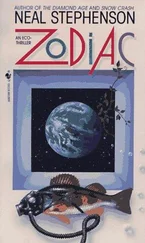“Elevations are of supreme importance in this project,” Goto Dengo tells the surveyor on the way up. They are burdened with surveying equipment and fresh water, but Ninomiya clambers up the rocky gulch of the half-parched river just as ably as Goto Dengo himself. “We will begin by establishing the level of Lake Yamamoto—which does not exist yet—and then work downwards from there.”
“I have also been ordered to obtain the precise latitude and longitude,” says Ninomiya.
Goto Dengo grins. “That's hard—there is nowhere to see the sun.”
“What about the three peaks?”
Goto Dengo turns to see if Ninomiya is joking. But the surveyor is looking intently up the valley.
“Your dedication sets a good example,” Goto Dengo says.
“This place is paradise compared to Rabaul.”
“Is that where you were sent from?”
“Yes.”
“How did you escape? It is cut off, isn't it?”
“It has been cut off for some time,” Ninomiya says curtly. Then, he adds: “They came and got me in a submarine.” His voice is husky and faint.
Goto Dengo is silent for a while.
Ninomiya has a system all worked out in his head, which they put into effect the next week, after they have done a rough survey of the Special Security Zone. Early in the morning, they hoist an enlisted man into a tree with a canteen, a watch, and a mirror. There is nothing special about this tree except for a bamboo stake recently driven into the ground nearby, labeled MAIN DRIFT.
Then Lieutenants Ninomiya and Goto climb to the top of the mountain, which takes them about eight hours. It is dreadfully arduous, and Ninomiya is shocked that Goto volunteers to go with him. “I want to see this place from the top of Calvary,” Goto Dengo explains. “Only then will I have the insight to perform my duty well.”
On the way up, they compare notes, New Guinea vs. New Britain. It seems that the latter's only saving grace is the settlement of Rabaul, a formerly British port complete with a cricket oval, now the linchpin of Nipponese forces in Southwest Asia. “For a long time it was a great place to be a surveyor,” Ninomiya says, and describes the fortifications that they built there in preparation for MacArthur's invasion. He has a draftsman's enthusiasm for detail and at one point talks nonstop for an hour describing a particular system of bunkers and pillboxes down to the last booby trap and glory hole.
As the climb gets harder, the two vie with each other in belittling its difficulty. Goto Dengo tells the tale of climbing over the snow-covered mountain range in New Guinea.
“Nowadays, on New Britain we climb volcanoes all the time,” Ninomiya says offhandedly.
“Why?”
“To collect sulfur.”
“Sulfur? Why?”
“To make gunpowder.”
After this they don't talk for a while.
Goto Dengo tries to dig them out of a conversational hole. “It'll be a bad day for MacArthur when he tries to take Rabaul!”
Ninomiya trudges along silently for a bit, trying to control himself, and fails. “You idiot,” he says, “don't you see? MacArthur isn't coming. There's no need.”
“But Rabaul is the cornerstone of the whole theater!”
“It is a cornerstone of soft, sweet wood in a universe of termites,” Ninomiya snaps. “All he has to do is ignore us for another year, and then everyone will be dead of starvation or typhus.”
The jungle thins out. The plants are wrestling for footholds on a loose slope of volcanic cinders, and only smaller ones endure. This puts Goto Dengo in the mind of writing a poem in which the small, tenacious Nipponese prevail over the big, lumbering Americans, but it has been a long time since he wrote a poem and he can't make the words go together.
Someday the plants will turn this cone of scoria and rubble into soil, but not yet. Now that Goto Dengo can finally see for more than a few yards he is beginning to understand the lay of the land. The numerical data that he and Ninomiya have compiled over the last week is being synthesized, within his mind, into a solid understanding of how this place works.
Calvary is an old cinder cone. It started as a fissure from which ash and scoria were ejected, one fragment at a time, for thousands of years, tumbling up and outwards in a family of mortar-shell-like parabolic curves, varying in height and distance depending on the size of each fragment and the direction of the wind. They landed in a wide ring centered on the fissure. As the ring grew in height it naturally spread out into a broad, truncated cone with a central pit gouged out of its top, with the spitting fissure in the bottom of that pit.
The winds here tend to come from a little bit east of due south, and so the ash tended to be pushed towards the north-by-northwest edge of the cone's rim. That is still the highest point of the cinder cone. But the fissure died out eons ago, or perhaps was plugged by its own emissions, and the whole structure has been much eroded since then. The southern rim of the cone is just a barrier of low hills perforated by the courses of the Yamamoto River and the two tributaries that come together to form the Tojo River. The central pit is a bowl of loathsome jungle, so saturated with chlorophyll that it looks black from above. Birds cruise above the canopy, looking like colored stars from up here.
The northern rim still rises a good five hundred meters above the bowl of jungle, but its formerly smooth arc has been dissected by erosion to form three distinct summits, each one a pile of red scoria half-concealed by a stubble of green vegetation. Without discussion, Ninomiya and Goto Dengo head for the one in the middle, which is the highest. They reach it at about two-thirty in the afternoon, and immediately wish they hadn't because the sun is beating almost straight down on top of them. But there is a cool breeze up here, and once they have protected their heads with makeshift burnooses, it's not so bad. Goto Dengo sets up the tripod and the transit while Ninomiya uses his sextant to shoot the sun. He has a pretty good German watch which he zeroed against the radio transmission from Manila this morning, and this enables him to reckon the longitude. He works the calculation out on a scrap of paper on his lap, then goes back and does it again to double-check the numbers, speaking them out loud. Goto Dengo copies them down in his notebook, just in case Ninomiya's notes get lost.
At three o'clock sharp, the enlisted man down in the tree begins to flash his mirror at them: a brilliant spark from a dark rug of jungle that is otherwise featureless. Ninomiya centers his transit on this signal and takes down more figures. In combination with various other data from maps, aerial photos and the like, this should enable him to make an estimate of the main shaft's latitude and longitude.
“I don't know how accurate this will be,” he frets, as they trudge down the mountain. “I have the peak exactly—what did you call it? Cavalry?”
“Close enough.”
“This means soldiers on horseback, correct?”
“Yes.”
“But the site of the shaft I will not have very precisely unless I can use better techniques.”
Goto Dengo considers telling him that this is perfectly all right, that the place was made to be lost and forgotten. But he keeps his mouth shut.
The survey work takes another couple of weeks. They figure out where the shore of Lake Yamamoto will be and calculate its volume. It will be more of a pond than a lake—less than a hundred meters across—but it will be deceptively deep, and it will hold a lot of water. They calculate the angle of the shaft that will connect the bottom of the lake to the main network of tunnels. They figure out where all of the horizontal tunnels will emerge from the walls of the Tojo River's gorge, and stake out the routes of roads and railways that will lead to those openings, so that debris can be removed and precious war material brought in for storage. They double– and triple-check all of it to make sure that no fragment of the works will be visible from the air.
Читать дальше





